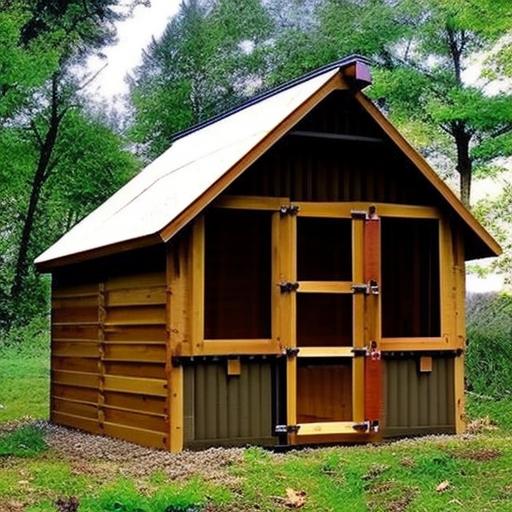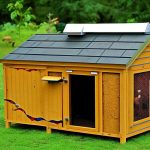Raising chickens has become increasingly popular among homeowners and homesteaders alike. Not only do chickens provide a sustainable source of fresh eggs, but they also offer numerous other benefits. Chickens help control pests in the garden, provide natural fertilizer for plants, and can even be a source of entertainment and companionship.
When it comes to building a chicken coop, there are many different designs to choose from. One popular option is the A-frame chicken coop. This style of coop offers several advantages that make it a great choice for both beginners and experienced chicken keepers.
Planning Your A-Frame Chicken Coop: Materials and Tools Needed
Before you start building your A-frame chicken coop, it’s important to gather all the necessary materials and tools. Choosing the right materials is crucial for the longevity and functionality of your coop. You’ll want to select materials that are durable, weather-resistant, and easy to clean.
For the frame of your A-frame chicken coop, you can use either wood or PVC pipe. Wood is a popular choice due to its strength and natural aesthetic. Cedar or pressure-treated lumber are good options as they are resistant to rot and insect damage. PVC pipe is another option that is lightweight, easy to work with, and resistant to moisture.
In addition to the frame materials, you’ll also need wire mesh for the walls and roof, roofing material, hinges for the door, screws or nails, and any additional hardware or accessories you plan to include in your coop.
Step-by-Step Instructions: Building the Foundation and Frame
Once you have gathered all the necessary materials and tools, it’s time to start building your A-frame chicken coop. The first step is to prepare the site where you will be placing your coop. Choose a level area that is well-drained and provides easy access for cleaning and maintenance.
Next, you’ll need to build the foundation of your coop. This can be done using concrete blocks, wooden posts, or even a raised platform. The foundation should be sturdy and level to ensure the stability of your coop.
After the foundation is in place, it’s time to construct the frame of your A-frame chicken coop. Start by building the two side walls, making sure they are the same height and angle. Then, connect the two side walls with a horizontal beam at the top to create the peak of the A-frame. Finally, add additional horizontal beams for stability and support.
Adding the Roof: Tips for Proper Installation
Choosing the right roofing material is essential for protecting your chickens from the elements and ensuring their comfort. There are several options to consider, including metal roofing, asphalt shingles, or even thatch.
Metal roofing is a popular choice due to its durability and longevity. It is also easy to install and provides excellent protection against rain, snow, and wind. Asphalt shingles are another option that offers good insulation and a traditional look. Thatch roofing can provide a natural and rustic aesthetic, but it may require more maintenance and replacement over time.
When installing the roof, make sure to secure it properly to prevent leaks and damage. Use screws or nails to attach the roofing material securely to the frame of your coop. It’s also important to ensure that the roof has a slight slope to allow for proper drainage.
Designing the Door and Windows: Functionality and Aesthetics
The door and windows of your A-frame chicken coop play an important role in both functionality and aesthetics. The door should be large enough for easy access when cleaning or collecting eggs, but also secure enough to keep predators out.
When choosing the location for your door and windows, consider factors such as sunlight exposure, ventilation, and ease of access. Windows should be strategically placed to allow for natural light and airflow, while also providing protection from drafts and extreme temperatures.
To add an extra layer of security, consider adding locks or latches to the door and windows. This will help keep your chickens safe from predators and ensure that they stay inside the coop when needed.
Nesting Boxes and Perches: Creating a Comfortable Space for Your Chickens
Creating a comfortable and functional space for your chickens to lay their eggs and roost is essential for their well-being. Designing and building nesting boxes is a key component of any chicken coop.
Nesting boxes should be dark, quiet, and private to encourage your chickens to lay their eggs. They should also be easily accessible for egg collection and cleaning. The size of the nesting boxes will depend on the number of chickens you have, but a general rule of thumb is one nesting box for every 3-4 hens.
In addition to nesting boxes, it’s important to provide perches for your chickens to roost on. Perches should be placed at varying heights to accommodate different sizes of chickens. They should also be made of smooth, rounded materials to prevent foot injuries.
Ventilation and Insulation: Keeping Your Chickens Healthy and Safe
Proper ventilation is crucial for maintaining a healthy environment inside your chicken coop. Good ventilation helps remove excess moisture, ammonia, and odors, which can lead to respiratory issues in chickens. It also helps regulate temperature and prevent the buildup of harmful gases.
To ensure proper ventilation, consider adding windows or vents that can be opened or closed as needed. These openings should be covered with wire mesh to prevent predators from entering the coop.
Insulation is another important consideration, especially if you live in an area with extreme temperatures. Insulating your A-frame chicken coop can help keep your chickens warm in the winter and cool in the summer. Insulation can be added to the walls, roof, and floor using materials such as foam board or fiberglass insulation.
Choosing the Right Flooring: Easy to Clean and Comfortable for Your Chickens
Choosing the right flooring material for your A-frame chicken coop is important for both cleanliness and comfort. The flooring should be easy to clean and disinfect to prevent the buildup of bacteria and parasites.
One popular option for chicken coop flooring is hardware cloth or wire mesh. This allows droppings to fall through, making it easy to clean. Another option is concrete, which is durable and easy to sanitize. However, concrete can be hard on chickens’ feet, so it’s important to provide a layer of bedding for comfort.
If you prefer a more natural option, you can use straw, wood shavings, or sand as bedding material. These materials provide cushioning for your chickens’ feet and help absorb moisture and odors. Just make sure to regularly clean and replace the bedding to maintain a clean and healthy environment.
Adding Feeders and Waterers: Ensuring Your Chickens Have Access to Food and Water
Providing your chickens with easy access to food and water is essential for their health and well-being. When choosing feeders and waterers, consider factors such as size, durability, and ease of cleaning.
There are many different types of feeders and waterers available, including hanging feeders, trough feeders, and automatic feeders. Choose the option that best suits your needs and the number of chickens you have.
When placing the feeders and waterers inside your A-frame chicken coop, make sure they are easily accessible but also protected from contamination. Elevating them off the ground can help prevent dirt, droppings, and pests from getting into the food and water.
Decorative Touches: Making Your A-Frame Chicken Coop Unique and Personal
While functionality is important when building a chicken coop, adding decorative touches can make it even more enjoyable and aesthetically pleasing. Personalizing your coop can also make it a unique and inviting space for both you and your chickens.
Consider adding paint or stain to the exterior of your coop to match your home or garden. You can also add decorative trim, window boxes, or even a small porch to enhance the overall look of your coop.
Inside the coop, you can add artwork, signs, or even curtains to make it feel more like a home. Just make sure any decorations are safe for your chickens and won’t pose a risk of injury or contamination.
Enjoying the Fruits of Your Labor and Watching Your Chickens Thrive.
Building an A-frame chicken coop is a rewarding project that offers numerous benefits for both you and your chickens. By providing a safe and comfortable space for your chickens to live, you can enjoy the rewards of fresh eggs and happy, healthy chickens.
Not only will you have a sustainable source of food, but you’ll also have the satisfaction of knowing that you are providing a natural and enriching environment for your chickens. Watching them thrive and interact with each other can be a source of joy and entertainment.
So, whether you’re a beginner or an experienced chicken keeper, consider building an A-frame chicken coop. With careful planning and attention to detail, you can create a functional and beautiful space for your chickens to call home.
Meet Walter, the feathered-friend fanatic of Florida! Nestled in the sunshine state, Walter struts through life with his feathered companions, clucking his way to happiness. With a coop that’s fancier than a five-star hotel, he’s the Don Juan of the chicken world. When he’s not teaching his hens to do the cha-cha, you’ll find him in a heated debate with his prized rooster, Sir Clucks-a-Lot. Walter’s poultry passion is no yolk; he’s the sunny-side-up guy you never knew you needed in your flock of friends!








